>[!NOTE]+ Meta
Author:: Satoshi Takahashi
Reference:: https://mainichi.jp/english/articles/20220401/p2a/00m/0et/034000c
Date:: 2022-04-03
Tags:: #Japan #ceramics
WeftLinks:: [[Cultural value of craft]] [[Psychological value of craft]]
[[Claim - Craft strengthens relationships between members of a cultural group]]
> [!SUMMARY] Summary
> A tradition of doll-making helps sustain a culture that meets the need to protect children.
### Notes

This article reflects on the Yabasa doll, made in Aikta Prefecture, Japan.
Here is some history:
> According to legend, production of the dolls commenced in Akita in the mid-Edo period (1603-1867), when artisans from the Fushimi area of Kyoto built kilns. At its peak, 500 types of molds were in use, and merchant ships ferried products to ports throughout the country via the Sea of Japan. Among the popular dolls was the "Tenjin-sama" -- the deified Sugawara no Michizane, a ninth century statesman and scholar. This doll, nicknamed "Yabase no Odentsan," would be presented to newborn boys. "Hina" dolls, depicting the Emperor and the Empress, were sent to girls. In either case, the sender hopes the gift brings good health to the child.
This tradition is being kept alive by Shu Umetsu, 72 years old. He established the group "Yabase-ningyo densho no kai" (Association for conveying Yabase dolls)
He finds there is still a strong need for these cultural objects:
>"About two years ago, a family who had lost a son when he was young purchased a Yabase doll of a bride as a religious offering," said Umetsu. I realized that the family was still praying for the boy's happiness, and that these dolls were close companions. I was moved to tears.